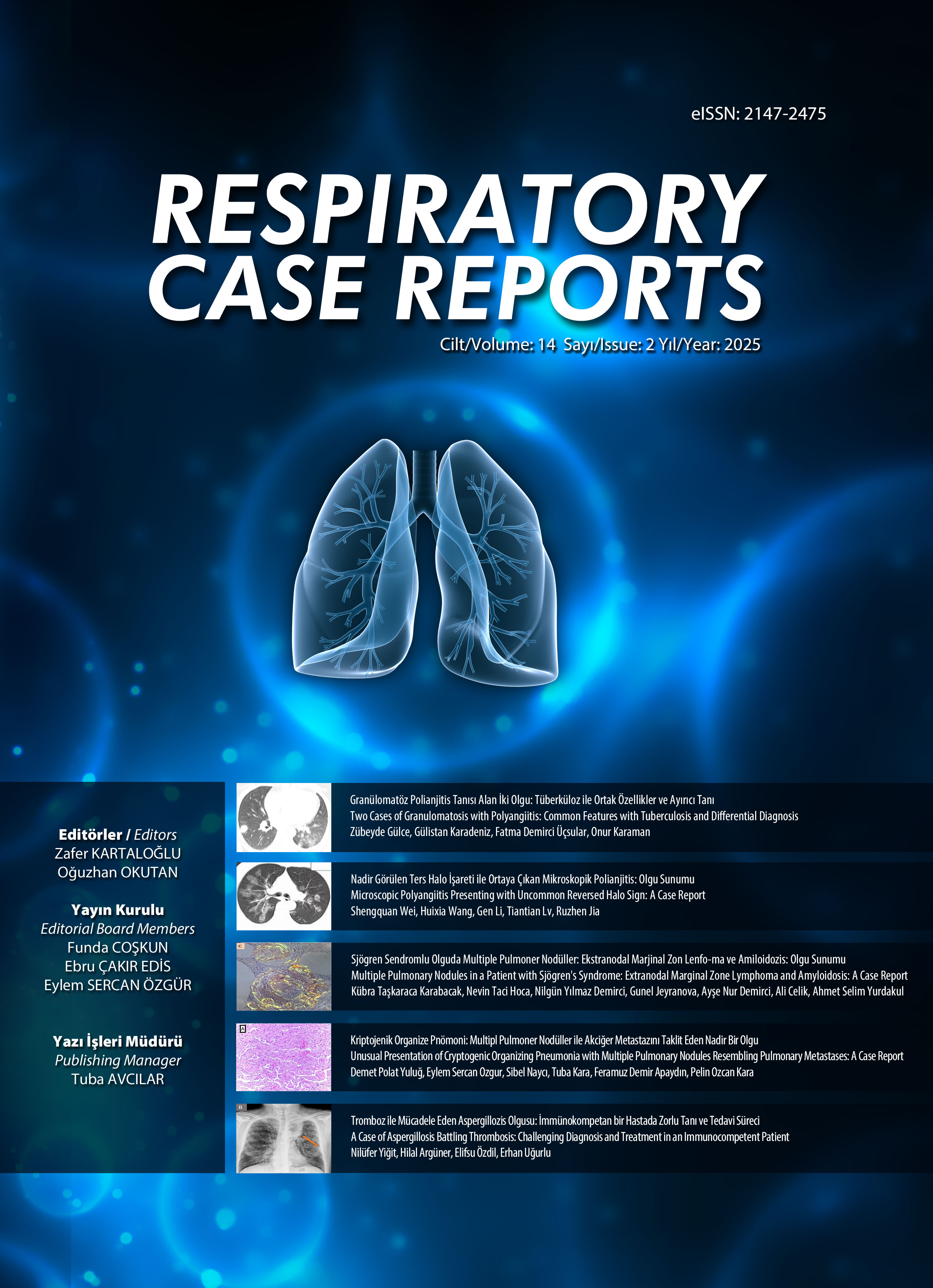e-ISSN 2147-2475

Volume: 2 Issue: 1 - February 2013
| COVER | |
| 1. | Cover Page I |
| EDITORIAL BOARD | |
| 2. | Editorial Board Page II |
| CASE REPORT | |
| 3. | Lung Toxicity Due To Mesalamine Ali İhsan Yıldız, Sibel Özkurt, Göksel Kıter, Zahide Alaçam, Belgin Erkan Aydoğan doi: 10.5505/respircase.2013.43531 Pages 1 - 5 Mesalamine, a widely used drug for inflammatory bowel disease, could cause pulmonary interstitial disease, like many other drugs. A 39-year-old woman with ulcerative colitis (UC) admitted with cough, dyspnea, and fatigue. Bilateral patchy alveolar infiltrations were seen on chest x-ray and tomography. Mesalamine was terminated, as the reaction was believed to be potentially caused by CU or due to the pulmonary toxicity of the drug. At the follow-up visit after 10 days, the initial infil-trations on chest radiograph improved. The patient's respiratory complaints had decreased significantly. As a result, mesalamine-induced lung toxicity was considered instead of lung involvement in patients with inflammatory bowel disease. |
| 4. | Etiology of Multiple Pulmonary Nodules: Mitral Stenosis Funda Aksu, Alper Yurdasiper, Serdar Akyüz doi: 10.5505/respircase.2013.08208 Pages 6 - 9 A 36-year-old male patient, with a history of mitral valve replacement (MVR) operation eight years prior, was admitted with chest pain. A physical examination revealed no pathologies except swelling, redness, and sensitivity on the site of the scar tissue of a sternotomy. Bilateral nodular densities were detected in the chest X-ray. Computed tomography of the thorax revealed calcification at the site of the mitral valve and randomly distributed, multiple millimetric pulmonary nodules, some of which were calcified. Underlying infectious, granulomatous, or neoplastic pathologies were not detected upon further evaluation, and the nodules were accepted as secondary to mitral valve stenosis. Chest pain was due to sternal wire sutures and was completely resolved after removal of the sutures. Patient was readmitted with hemoptysis and severe chest pain 16 months after the first admission. Cardiac evaluation revealed that hemoptysis and the pulmonary nodules were caused by pulmonary congestion together with increases in the left atrial pressure, due to ineffective warfarin treatment after the MVR operation. Rheumatic heart diseases should be a part of the differential diagnosis in researching the etiology of pulmonary nodules, as they continue to be encountered frequently in Turkey. |
| 5. | Anaphylaxis and Diffuse Alveolar Hemorrhage Following Bee Sting Işıl Fatma Uzel, Metin Arslan, Özkan Demirhan doi: 10.5505/respircase.2013.00710 Pages 10 - 13 Insect stings and subsequent reactions are com-mon occurrences, but life-threatening systemic reactions are quite rare. Diffuse alveolar hemor-rhage is a clinical entity seen in many different disease processes and includes hemoptysis, anemia, diffuse radiographic pulmonary infiltrates, and hypoxemic respiratory failure, which can be severe. Radiologic features may mimic cardiogenic pulmonary edema, severe infection or uremia. We describe a 23-year-old girl who developed symptoms of anaphylactic shock and diffuse alveolar hemorrhage within 30 minutes following a bee sting. |
| 6. | BOOP (Bronchiolitis Obliterans Organizing Pneumonia) and Renal Amyloidosis Secon-dary to Infected Cystic Bronchiectasis Dilay Çimen, Mehmet Ekici, Emel Bulcun, Aydanur Ekici doi: 10.5505/respircase.2013.19480 Pages 14 - 19 Amyloidosis is group of conditions occurring as a result of abnormal storage of a specific protein, amyloid, in various tissues in the body. Organizing pneumonia, a rarely seen within lung diseases, but rather possessing a characteristic clinicopathologic features is a table. A case applied to our hospital with shortness of breath, cough, sputum, and chest pain. Heterogeneity at the left paracardiac borderline, by closing the left sinus, was observed in the posteroanterior chest x-ray. Reticulonodular changes on the basis of extensive ground-glass density, locally consolidated areas, changes in bronchiectasis, and a loss of volume in the apical-posterior segment of the upper and lower lobes of the left lung were determined by High-resolution computed tomography. Because of proteinuria, renal biopsy was performed on the basis of renal amyloidosis. The pathologic examination was consistent with renal amyloidosis. A biopsy was carried out by fiberoptic bronchoscopy in the lower left lobe mucosa from the area of white plaque. The biopsy specimen was compatible with "organized pneumonia (interstitial pneumonia and interstitial fibrosis). Secondary amyloidosis and bronchiolitis obliterans organizing pneumonia with renal involvement, progressing due to infected cystic bronchiectasis, are presented in this study. |
| 7. | Corneal Opacity: A Rare Manifestation of Cystic Fibrosis Sevgi Pekcan, Deniz Doğru Ersöz, Mehmet Köse, Güzin Cinel, Murat İrkeç, Ebru Yalçın, Uğur Özçelik, Nural Kiper doi: 10.5505/respircase.2013.19483 Pages 20 - 22 Eye manifestations due to hypovitaminosis A was observed in the follow-up of patients with cystic fibrosis. Herein, we describe an 11-month-old infant with corneal opacity and growth retardation who was diagnosed as cystic fibrosis. To our knowledge, this is the first report in the literature of corneal opacity as a manifestation of cystic fibrosis. Furthermore, it is rare to encounter ophthalmic findings in cystic fibrosis at this age. |
| 8. | Fatal Dental Abscess: Descending Necrotising Mediastinitis Atalay Şahin, Fatih Meteroglu, İsmet Rezani Toptanci, Tahir Şevval Eren, Canan Eren doi: 10.5505/respircase.2013.58066 Pages 23 - 26 Mediastinitis is a rare infectious disease around the vital organs in the mediastinum. Descending necrotizing mediastinitis (DNM) is caused by odontogenic, pharyngeal, cervical infections, sternotomy or diagnostic and therapeutic instrumentation. Unless it is diagnosed in a timely manner and properly treated, the outcome is fatal. Delay in treatment leads to the spread of the infection down to the mediatinum. We present a case of DNM in 17-year-old girl suffering from a dental abscess. |
| 9. | Tuberculosis Case Presented with a Solid Mass Lesion in the Lung Sinem Nedime Sökücü, Levent Dalar, Cengiz Özdemir, Songül Büyükkale, Ayşegül Akbaş, Sedat Altın doi: 10.5505/respircase.2013.66376 Pages 27 - 31 Tuberculosis can be presented with different radiological forms. Mass lesion with the diagnosis of pulmonary tuberculosis is not rare in literature. Sometimes it is challenging to be sure of the diagnosis of tuberculosis and excludes coexisting cancer in a patient presented with mass lesion. In this paper diagnostic difficulties and follow up of a 45 years old male patient with a family history of lung cancer and a smoking history (25 packs/years) who was presented with a mass lesion on his chest radiography is discussed with review of literature. We would like to emphasize the difficulties of differential diagnosis in communities in which both of the clinical situations were common. |
| 10. | A Case of Hydatid Cyst Mimicking Superior Sulcus Tumor: Intrathoracic, Extrapulmonary, Intraosseous Location Fatih Meteroglu, Atalay Sahin, Sevval Eren doi: 10.5505/respircase.2013.68077 Pages 32 - 34 Hydatid cysts are rarely located outside of the liver and lungs. Exceptional locations, such as the in-traosseous part of the rib can cause unusual symp-toms. An accurate preoperative diagnosis is im-portant, but may be confusing in some cases. The presented case here is an example of echinococcosis of the first rib in a young adult who complained of shoulder pain. Plain chest x-ray and computerized tomography scan were suggestive of a superior sulcus tumor. The lesion was resected and the histopathological examination confirmed hydatid disease. |
| 11. | Primary Pulmonary Leiomyosarcoma Nurdan Şimşek Veske, Gülşah Günlüoğlu, Adalet Demir, Pelin Karadağ, Ekrem Cengiz Seyhan, Nur Ürer, Sedat Altın doi: 10.5505/respircase.2013.35744 Pages 35 - 38 Leiomyosarcoma is a tumor of the smooth muscle cells which frequently originates in the uterus, retro-peritoneum, and within the abdomen. Although there are a large number of smooth muscle cells in the tracheobronchial tree, primary pulmonary muscle tumors rarely occur. A 48-year-old male patient with no symptoms was admitted to our department following the inadvertent detection of a lesion in his chest x-ray. Through thoracic computerized tomography, a 4x3 cm diameter mass lesion was located in the lower right lobe. In the positron emission tomography-computed tomography (PET/CT) scan with a fluorodeoxyglucose (FDG) tracer, low FDG uptake was observed in the lesion. Computer tomography-guided needle aspirations were carried out. In the absence of a histopathological diagnosis, surgery was planned for diagnosis and treatment. A lower lobe wedge resection was completed using video-assisted thoracic surgery (VATS). A diagnosis of primary pulmonary leiomyosarcoma was made based on postoperative pathology results. |
| 12. | Delayed Diagnosis in a Patient with Bronchiectasis: Swyer-James-MacLeod Syndrome Dilay Ahat Çimen, Aydanur Ekici, Emel Bulcun, Mehmet Ekici doi: 10.5505/respircase.2013.14622 Pages 39 - 43 Swyer-James/MacLeod syndrome (SJMS) is a rare disease, characterized by unilateral hyperlucent lung due to hypoplasia of the pulmonary artery and bronchiectasis. Illnesses such as viral bronchiolitis and pneumonia in childhood are thought to be an acquired form. A 48-year-old woman applied to the hospital with symptoms including shortness of breath, sputum, and cough. Her medical history revealed that these symptoms had been relapsing since her childhood. She had been diagnosed and monitored for chronic bronchitis and bronchiectasis for the past 10 years. A physical examination revealed that the respiratory sounds of the lower left lobe decreased more than the right side, and revealed coarse crackles in the both middle, anterior, and inferior hemithorax. Chest radiography showed a loss of volume of the left lung, hiperlucency, and areas of bronchiectasis in the lower left lobe. Computed tomography showed that calibration of left pulmonary artery and its branches significantly decreased compared to the right side. We present our case simply because the majority of SJMS cases are diagnosed in childhood and young adulthood; however, our patient was examined several times with the same symptoms and not diagnosed until the age of 48. This syndrome should be considered in the differential diagnosis of patients who have hyperlucent lung. |
| 13. | Scimitar Syndrome Associated with Agenesis of Right Pulmonary Artery Dilaver Taş, Oğuzhan Okutan, Tuncer Özkısa, Ömer Ayten, Ersin Demirer, Turgut Öztutgan doi: 10.5505/respircase.2013.96268 Pages 44 - 47 Scimitar syndrome is a very rare disorder and also known as hypogenetic lung syndrome. The syndrome is characterized with anomalous connection of the pulmonary vein with the vena cava inferior. In this text, scimitar syndrome associated with pulmonary artery hypoplasia is presented. A 21-year-old male patient with complaints of cough, shortness of breath and sputum was admitted. Chest X-ray revealed volume loss of right lung and shift to the right of heart and mediastinum. The middle lobe wasnt observed in bronchoscopy and thorax CT. Thoracic CT angi-ography images revealed that vein of right lung lower lobe drains right hepatic vein and right pulmonary artery diameter is reduced. Lung perfusion scintigraphy revealed total loss of perfusion of right lung. Scimitar sign on chest X ray is characteristics for scimitar syndrome. However, this sign cannot be seen in some patients. If there is volume loss of right lung and shift to the right of heart and mediastinum, scimitar syndrome should be considered in addition to other diseases. |











